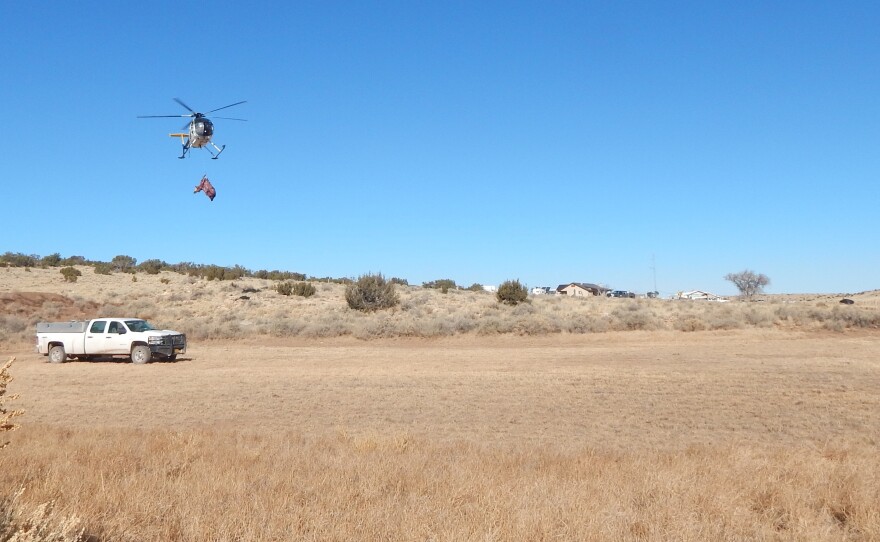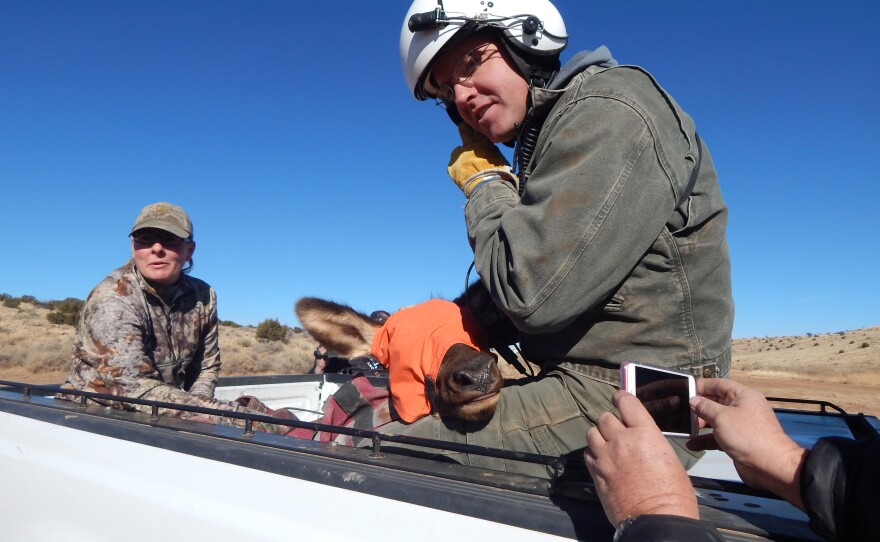Sixty elk from northern Arizona start a 2,000-mile journey this month to a wildlife reserve in West Virginia. Elk were eradicated by overhunting in the eastern United States more than a century ago and now West Virginias want to bring the animals back. Organizers of the relocation project say it’s about correcting past mistakes, and Arizona is in a unique position to help. KNAU’s Melissa Sevigny reports.
A helicopter flies low over rolling grasslands east of Flagstaff dangling an unusual cargo: a full grown elk cocooned in fabric. It’s being transferred into the bed of a pickup truck.
Mark Stewart of the Arizona Game and Fish Department looks on. “It’s hobbled, it’s blindfolded, and it’s got a light tranquilizer to keep it a little more calm,” he says.
A wildlife biologist waits to guide the 600-pound animal into the truck. Stewart narrates: “He’s got a hold of it—in about two seconds he’ll release that line—line is dumped, elk is in the truck, and the helicopter is taking off to go get another one.”

The elk is destined for a wildlife management area in West Virginia. It’s a rare collaboration between the East and the West to correct an old mistake. Stephen McDaniel, director of the West Virginia Division of Natural Resources, says European settlers hunted elk on the East Coast to extirpation.
“The last known elk in West Virginia was killed in the 1860s,” McDaniel says. “What we’re trying to do with this program, like many other states in the east, is to reestablish elk to its native home range.”
McDaniel hopes the program will bring in wildlife-watching tourists and eventually allow for an elk hunt: but he says, economic considerations aside, it’s the right thing to do.
“Elk is the natural animal to bring back,” he says. “We’ve also reestablished the otter, the beaver. All the animals that were here for centuries, for thousands of years, I think as we restore the habitat in the wild, it’s our duty to try to reestablish the animals that once roamed all those areas.”
Arizona’s elk herds are healthy and free of disease, including Chronic Wasting Disease, a deadly brain infection that has stricken at least 22 states. That’s why McDaniel approached biologists here about bundling up a few elk for a cross-country trek.
They’ll be released into thirty thousand acres of meadows and woods in West Virginia, in an area once destroyed by coal mining but now restored with clover and grass. “Everything they need is right there, the habitat, the water, all the food…It’s turned out to be a perfect place to put elk,” McDaniel says.
Amber Munig, the big game program supervisor for Arizona Game and Fish, says this is the only second time Arizona has sent its elk to another state. Kentucky received some back in 2000 for a similar repopulation effort.
“[It’s] not something we get to do very often, but when we get to help another state establish a population and further conservation, it’s something that we jump on as quickly as we can,” she says.
After all, Munig says, Arizona once got the same help. The state’s native elk population vanished in the late 1800s, but it received a shipment of elk from Yellowstone National Park in 1913. The descendants of those imported animals now number in the tens of thousands.
This is probably a once-in-a-lifetime type of thing for Arizona. - Anne Justice-Allen
“These populations across this portion of Arizona have been reproducing very well and so they’re robust enough to support removal,” Munig says.
A truck rumbles up carrying a recently captured female elk. Half a dozen people crowd round to lift her into the holding area. Munig explains, “They’ll offload that elk and then we’ll do a health assessment on it, we’ll put the radio collar on it and the ear tags.”
Veterinarian Anne Justice-Allen is on hand to make sure the animals are healthy before their 30-hour drive to West Virginia. She checks the elk’s temperature and gives her a couple of shots. “This is actually a first for me, so it’s very exciting,” she says. “I have not had a chance to handle wild elk before… This is probably a once in a lifetime type of thing for Arizona.”
When the checkup is complete, the Game and Fish biologists and volunteers remove the hobbles and blindfold and then jump back. The elk bolts to her feet and clatters into the pen.
The sixty elk are now waiting out a month-long quarantine before they’re loaded into cattle trucks and shipped nonstop to their new home in West Virginia.















